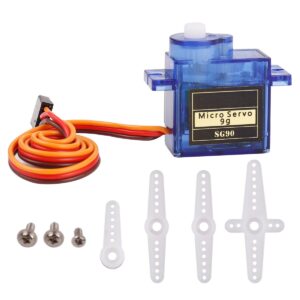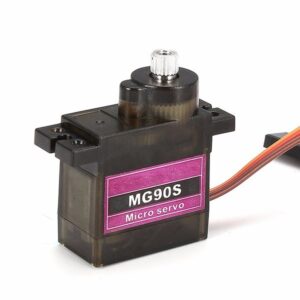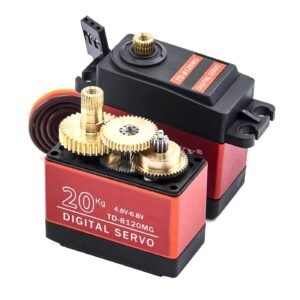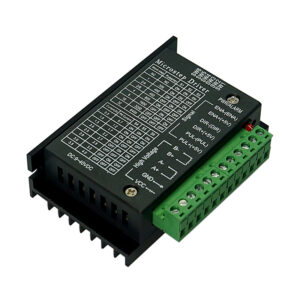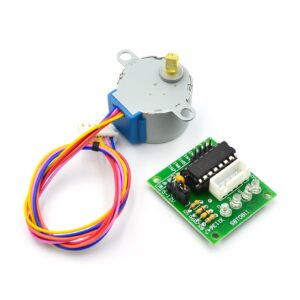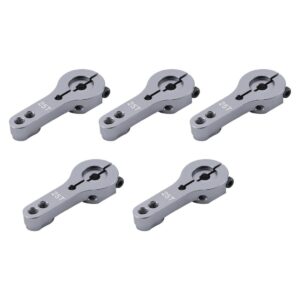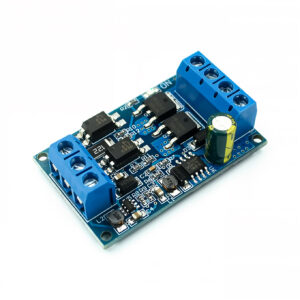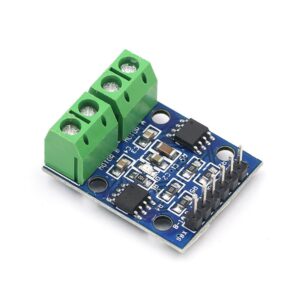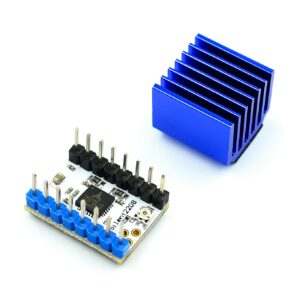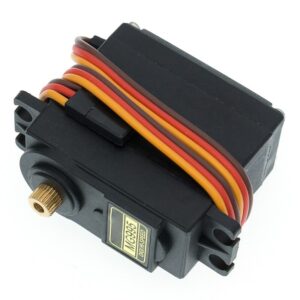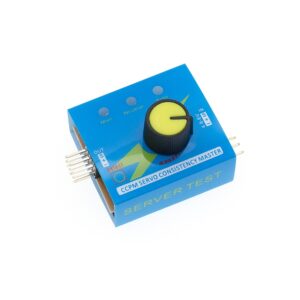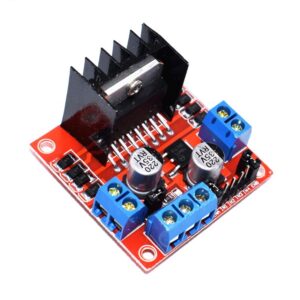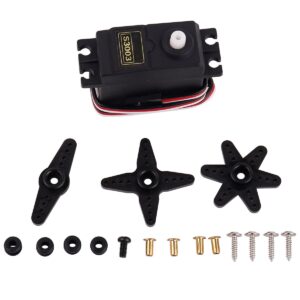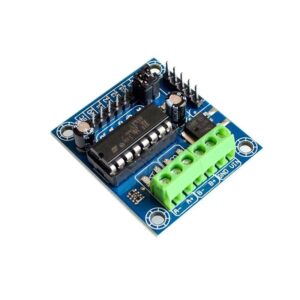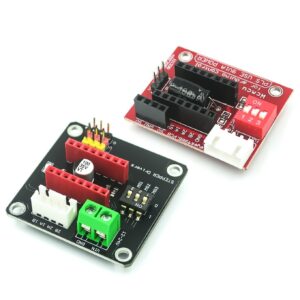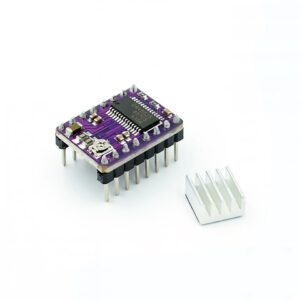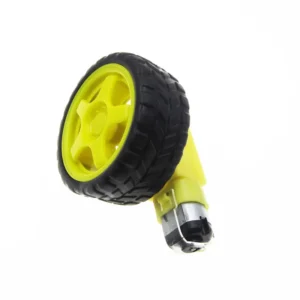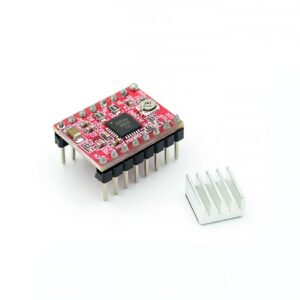Servo Motors and Motor Drivers
Showing all 20 results
- £2.35 – £19.90 Select options This product has multiple variants. The options may be chosen on the product page
- £2.90 – £12.90 Select options This product has multiple variants. The options may be chosen on the product page
- £3.25 – £4.45 Select options This product has multiple variants. The options may be chosen on the product page
- £2.90 Select options This product has multiple variants. The options may be chosen on the product page
- £0.95 – £1.85 Select options This product has multiple variants. The options may be chosen on the product page
Showing all 20 results
What Are Servo Motors and Motor Drivers?
Servo motors and motor drivers are integral components in various applications requiring precise control of position, speed, and torque. A servomotor, often paired with a servo drive, utilises a control loop system to accurately follow the desired command value set by the motion controller. By receiving feedback from an encoder, the system adjusts to maintain the accuracy of the motor’s position and torque. These attributes make servo motors and motor drivers critical in fields such as robotics, CNC machinery, and automated manufacturing.
The Different Types of Servo Motors and Motor Drivers
Understanding the different types of servo motors and motor drivers is essential for selecting the right components for specific applications. These devices operate either in an open loop or closed loop configuration, where closed loop systems provide continuous feedback for high precision control. With different speed control mechanisms and feedback loops, each type of servo motor and motor driver offers unique benefits for various industrial and automation needs.
Stepper Motor Driver
A stepper motor driver is essential for controlling stepper motors, which are known for their precision and incremental movement capabilities.
Stepper motor drivers serve as the intermediary between a stepper motor and the control system, providing the necessary power and signals for precise movement. By controlling the current and voltage supplied to the motor’s coils, the driver can dictate the motor’s steps, enabling accurate positioning and rotational control. The control loop in this system ensures feedback mechanisms are in place to monitor and adjust the motor’s performance in real-time, allowing for consistent and reliable operation. Stepper motor drivers find applications in robotics, 3D printers, CNC machines, and automation systems where precise motion control is required.
TMC2208 DRV8825 A4988 Stepper Motor Driver
The TMC2208, DRV8825, and A4988 stepper motor drivers are popular choices for applications requiring reliable control and efficient torque management.
One notable feature of the TMC2208 driver is its stealthChop technology, which allows for silent operation by using voltage waves instead of traditional PWM control. This results in reduced noise and smoother movement.
The DRV8825 stands out for its ability to handle higher currents up to 2.5A per phase, making it suitable for demanding applications that require more power. It offers microstepping up to 1/32 steps, enabling precise control over movements.
On the other hand, the A4988 is known for its simplicity and cost-effectiveness, making it a popular choice for hobbyist projects and simpler applications. It is capable of providing up to 2A output current per coil.
TT Motor and Tyre
TT Motor and Tyre assemblies are commonly used in robotics and automation projects for their simplicity and effectiveness in position control.
These assemblies are highly versatile and can be found in various applications, from small-scale hobby robots to industrial machinery. TT Motors are known for their precise speed and torque control, making them ideal for tasks requiring accurate positioning such as conveyor systems, CNC machines, and robotic arms. When paired with advanced motion controllers, TT Motors and Tyres can achieve complex motion sequences with ease, enhancing the overall efficiency and performance of the system.
5V 4-Phase Geared Stepper
The 5V 4-Phase Geared Stepper motor is designed for applications requiring precise control of the rotation angle and integration with linear encoders.
These motors are known for their high level of accuracy, making them ideal for applications where maintaining precise positioning is crucial. They offer smooth operation and consistent performance, ensuring that the rotation angles are controlled with precision.
Linear encoders play a critical role in enhancing the overall performance of these motors by providing real-time feedback on position, velocity, and acceleration. This feedback loop enables the motor to make adjustments as needed, resulting in improved accuracy and efficiency in various applications.
L298N Dual H Bridge
The L298N Dual H Bridge motor driver is versatile for controlling the speed and torque of two DC motors simultaneously.
One of the key functions of the L298N Dual H Bridge is its ability to provide bidirectional control for each motor, allowing for easy forward and reverse movements.
With its built-in H-bridges, this motor driver can handle higher currents, making it ideal for robotic projects, electric vehicles, and other applications that require precise motor control.
The L298N Dual H Bridge has integrated freewheeling diodes, providing protection against back electromotive force (EMF) that occurs when the motor decelerates.
MG90 Servo Motor with Metal Gear
The MG90 Servo Motor with Metal Gear is renowned for its high precision and robust feedback mechanism, making it ideal for demanding applications.
One of the key benefits of the MG90 Servo Motor lies in its metal gearing, which enhances its durability and longevity, allowing it to withstand rigorous usage in various industries. The incorporation of a reliable feedback system ensures that the motor operates with exceptional precision, making it a preferred choice for applications where accuracy is crucial.
MG995 All Metal Gears
The MG995 with all metal gears provides superior torque and precise control over the rotation angle, making it a preferred choice for heavy-duty applications.
Individuals who rely on the MG995 servo motor can be assured of its remarkable durability and consistent performance under demanding conditions. The utilization of metal gears sets this servo apart, ensuring reliable operation even in high-stress situations. Its impressive torque capabilities enable it to handle significant loads with ease, making it ideal for tasks that require substantial power.
The MG995 excels in offering precise control over rotation angles, allowing for accurate positioning and smooth movements. Whether used in robotics, RC vehicles, or other mechanical systems, users appreciate its ability to deliver reliable and efficient performance time and time again. Its sturdy construction not only enhances its longevity but also contributes to its overall robustness, instilling confidence in its consistent operation.
Micro Servo Motor
Micro Servo Motors are compact yet powerful, offering precise position control with the aid of feedback encoders.
One of the key advantages of these motors lies in their small size, making them incredibly versatile in various applications requiring intricate movements and limited space constraints.
Due to their compact nature, Micro Servo Motors can be easily integrated into intricate robotic systems, drones, camera gimbals, and medical instruments where precision and agility are crucial.
When equipped with feedback encoders, these motors can achieve unparalleled accuracy and repeatability in positioning tasks, ensuring that the desired location is consistently maintained.
In addition to servo motors, Arduino shields are also commonly used in Arduino projects. Shields are add-on boards that can be attached to an Arduino board to provide additional functionality, such as wireless communication, data logging, or motor control.
How Do Servo Motors and Motor Drivers Work?
Servo motors and motor drivers work in tandem to achieve precise control over mechanical movements by utilising a closed-loop system. The servomotor receives commands from a motion controller and adjusts its position and torque based on feedback provided by an encoder.
What Are the Uses of Servo Motors and Motor Drivers?
Servo motors and motor drivers are pivotal in numerous applications, including robotics, CNC machinery, and automated manufacturing, due to their precision and reliability.
Robotics
In robotics, servo motors are crucial for controlling the position and torque of robotic arms and joints.
These compact yet powerful motors play a pivotal role in ensuring precise and accurate movements in robotic systems. By receiving input signals from sensors, servos can adjust their rotation angle and speed with remarkable agility. This capability enables robots to perform intricate tasks with a high level of accuracy and efficiency. Servo motors contribute significantly to the overall performance of a robot, allowing it to carry out complex manoeuvres and actions with consistency and reliability.
CNC Machines
Servo drives are integral to CNC machines, providing the feedback necessary for high-precision cutting and milling operations.
In CNC machinery, servo drives play a crucial role in controlling the motion of the axis and ensuring accurate positioning during operations. The feedback mechanism in servo drives allows for real-time monitoring and adjustment, resulting in precise and consistent output. This is particularly important in industries such as aerospace, automotive, and manufacturing, where tight tolerances are essential for quality and productivity.
Common CNC applications where servo drives are used include laser cutting machines, 3D printers, woodworking routers, and metal lathes. These applications rely on servo drives to translate digital commands into smooth and synchronized movements, enabling intricate designs and complex machining processes with utmost accuracy.
3D Printers
Servo motors are utilised in 3D printers to maintain accurate positioning and control throughout the printing process.
These motors play a crucial role in ensuring that the printer’s extruder and build platform move precisely as commanded, resulting in high-quality prints. By meticulously following the instructions from the printer’s firmware, servo motors enable intricate designs with fine details.
The feedback mechanism of servo motors facilitates closed-loop control, where any deviations in positioning are swiftly corrected. This continuous monitoring and adjustment allow for consistent layer deposition, reducing errors and ensuring dimensional accuracy in the final prints.
RC Vehicles
In RC vehicles, servomotors provide precise speed control and manoeuvrability.
Servomotors are a critical component in RC vehicles due to their ability to offer fine-tuned control over the speed and rotation of various vehicle parts.
By integrating servomotors, RC enthusiasts can experience smoother movements and more accurate steering responses.
These components also allow for quick adjustments in real-time, making it easier for operators to navigate obstacles and control the vehicle with precision.
Industrial Automation
Servo motors are essential in industrial automation, providing the necessary torque and precision, supported by advanced feedback systems.
These motors play a crucial role in various applications, such as robotics, CNC machines, conveyor systems, and more. The ability of servo motors to adjust their performance based on feedback signals ensures accurate positioning and speed control. By receiving continuous input from sensors, servo motors can make real-time adjustments to maintain optimal performance levels, resulting in smooth and efficient operation within automated systems.
Things to Consider When Choosing Servo Motors and Motor Drivers
When choosing servo motors and motor drivers, several factors should be considered, including torque requirements, power source compatibility, control method, size and weight, and price and quality. Evaluating these criteria ensures that the selected components meet the specific needs of your application, whether it involves high precision, robust performance, or cost-effectiveness.
Torque and Speed
The torque and speed requirements of the application should be the primary considerations when selecting a servo motor.
When evaluating the torque needs, it is crucial to assess the maximum load that the motor will need to move, taking into account any potential variations in the load during operation.
Similarly, for speed requirements, factors such as the desired operating speed range and the acceleration and deceleration rates must be carefully analysed.
Matching the torque and speed specifications with the servo motor capabilities is essential to ensure optimal performance and efficiency.
Power Source
Ensuring compatibility between the servo drive and the available power source is crucial for optimal performance.
When the power source matches the servo drive’s voltage and current requirements, the system operates smoothly, maximising efficiency and preventing potential damage. If the power source doesn’t meet these specifications, issues such as erratic behaviour, overheating, or even equipment failure may arise. It’s essential to carefully check the technical specifications of both the servo drive and the power source to ensure they are compatible.
Control Method
The control method used by the servo motor, whether open loop or closed loop, determines how feedback and command values are managed.
Open loop control relies solely on the input command without receiving feedback regarding the output. It is a simpler and cost-effective method but might lack accuracy.
On the other hand, closed loop control continuously adjusts the output based on feedback, ensuring precision and stability. The closed loop system is more complex and expensive due to the feedback mechanism.
When choosing between the two, consider the application requirements; for applications where precision is crucial, closed loop control is preferred, while open loop control is suitable for simpler tasks where accuracy is not a primary concern.
Size and Weight
The size and weight of the servo motor are important factors, especially in applications with space or weight constraints.
For instance, in industries like robotics, where precise movements are crucial, choosing a compact and lightweight servo motor can make a significant difference in overall performance. In manufacturing processes that involve intricate machinery setups, having smaller and lighter servo motors can enhance flexibility and ease of integration.

